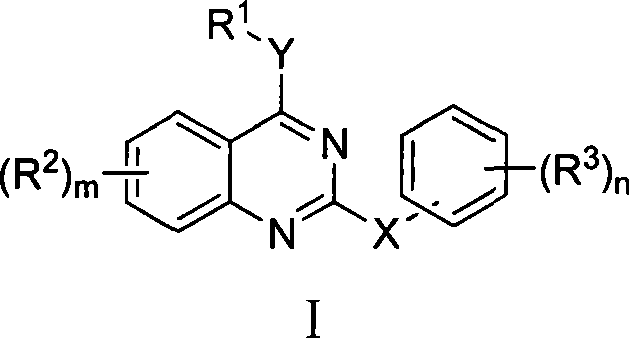Diaryl benzo pyridine derivative, and preparation and use thereof
A technology of benzopyrimidine and diaryl, which is applied in the application and preparation field of related drugs, and achieves the effects of low cytotoxicity, novel structure and simple preparation method
- Summary
- Abstract
- Description
- Claims
- Application Information
AI Technical Summary
Problems solved by technology
Method used
Image
Examples
Embodiment 1
[0041] Embodiment 1: Synthesis of diarylbenzopyrimidine derivatives (method 1)
[0042] Under the protection of an inert gas, add substituted phenol (or aniline, etc.) 2 CO 3 , control the temperature at 80-120°C, and stir for 8-12 hours. After TLC showed that the reaction was finished, the K 2 CO 3, the filtrate was poured into cold water, the precipitated solid was filtered and dried. Decolorized by activated carbon and recrystallized from toluene to obtain the desired compound.
[0043] With different 4-chlorobenzopyrimidine derivatives and different substituted phenols (or aniline, etc.). The target compound was prepared respectively by the above method, and some results are as follows:
[0044] Under N2 protection, 2-methylphenol (4.2mmol) was added to 30mL of anhydrous DMF, stirred to dissolve it, and then 2-(4-cyanoanilino)-4-chlorobenzopyrimidine (3.5mmol ), stirred for 10min to dissolve it, added anhydrous K 2 CO 3 (0.021mol), the temperature was controlled a...
Embodiment 2
[0058] Example 2: Synthesis of diarylbenzopyrimidine derivatives (method 2)
[0059] Mix 2-methoxyphenol and 2-chlorobenzopyrimidine derivatives together, heat to 150-210°C until the reactants are completely melted, and react for 1 hour. TLC showed that after the reaction was completed, it was dissolved in DMF, decolorized by activated carbon, filtered, and the filtrate was poured into cold water, and the precipitated solid was filtered and dried. Recrystallization from toluene afforded the desired compound.
[0060]
[0061] White flocculent solid, yield 82.9%; melting point: 220.0-220.5°C; 1 H NMR (DMSO-d 6 ) δ (ppm) 3.73 (s, 3H, CH 3 O), 7.10(td, 1H, J=7.6Hz, J`=1.6Hz, Ar`H 6 ), 7.30 (dd, 1H, J=8.4Hz, J`=1.2Hz, Ar`H 3 ), 7.35-7.41 (m, 2H, Ar`H 4,5 ), 7.47 (td, 1H, J=8.0Hz, J`=0.8Hz, ArH 7 ), 7.56(d, 2H, J=8.8Hz, Ar``H 2,6 ), 7.71 (d, 1H, J=8.4Hz, ArH 6 ), 7.84(d, 2H, J=8.8Hz, Ar``H 3,5 ), 7.89 (td, 1H, J=8.4Hz, J`=1.2Hz, ArH 8 ), 8, 22 (d, 1H, J=8.4Hz, ArH 9 ...
Embodiment 3
[0076] Example 3 Anti-HIV biological activity test
[0077] The anti-HIV virus activity at the cell level in vitro was determined by the Rega Institute of Pharmacy at Katholleke University in Belgium, mainly including two aspects: inhibitory activity and cytotoxicity to HIV-infected MT-4 cells. The method is as follows: make the compound in HIV-infected MT-4 cells, at different times of HIV infection, use the MTT method to measure the protective effect of the drug on HIV-induced cytopathy, and calculate that 50% of the cells are free from HIV-induced cytopathy half effective concentration IC 50 , Toxicity determination is carried out in parallel with anti-HIV activity experiment, also in MT-4 cell culture, the concentration that makes 50% uninfected cells take place cytopathic (CC 50 ), and calculate the selectivity index SI=CC 50 / IC 50 .
[0078] Materials and Methods:
[0079] The anti-HIV activity of each compound is monitored by the inhibitory effect of the drug on the...
PUM
 Login to View More
Login to View More Abstract
Description
Claims
Application Information
 Login to View More
Login to View More - R&D
- Intellectual Property
- Life Sciences
- Materials
- Tech Scout
- Unparalleled Data Quality
- Higher Quality Content
- 60% Fewer Hallucinations
Browse by: Latest US Patents, China's latest patents, Technical Efficacy Thesaurus, Application Domain, Technology Topic, Popular Technical Reports.
© 2025 PatSnap. All rights reserved.Legal|Privacy policy|Modern Slavery Act Transparency Statement|Sitemap|About US| Contact US: help@patsnap.com



